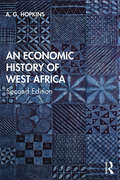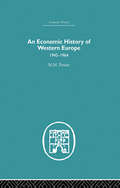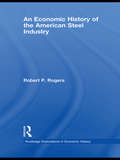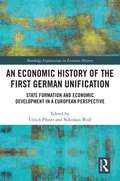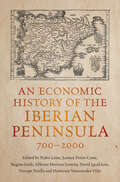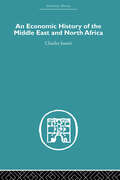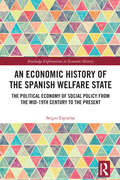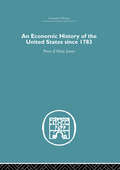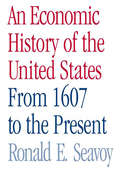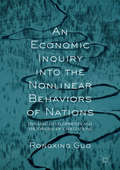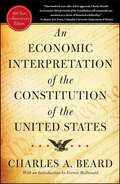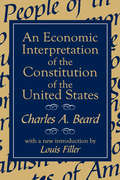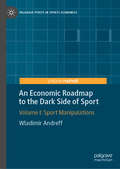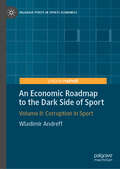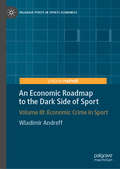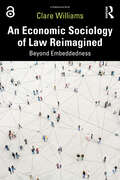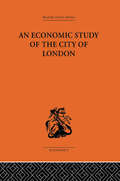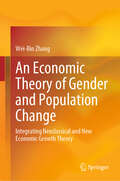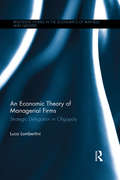- Table View
- List View
An Economic History of West Africa
by A. G. HopkinsThis pioneering and celebrated work was the first, and remains the standard, account of the economic history of the huge area conventionally known as West Africa. The book ranges from prehistoric times to independence and covers the former French territories, as well as those colonised by the British. It criticises conventional beliefs about economic backwardness, offers an alternative account that explains the particular configuration of poverty that characterised the pre-colonial period, and assesses the consequences of the region’s interaction with the wider world – from the growth of the Saharan and Atlantic trades to the rise and demise of colonial rule. This edition contains a substantial new Introduction that discusses the development of the subject during the past 50 years, evaluates the debate over the original interpretation, and provides a valuable guide to further reading, bringing the reader up to date with current scholarship on the subject, as well as providing avenues for further independent research. Appearing at a time when the study of African economic history is enjoying a revival and is engaging economists as well as historians, the book fills a large gap in African studies, provides newcomers with a stimulating point of entry into the subject, and contributes to our understanding of wider issues of global underdevelopment.
An Economic History of Western Europe 1945-1964 (Economic History Ser.)
by M.M PostanFirst Published in 2005. Routledge is an imprint of Taylor & Francis, an informa company.
An Economic History of the American Steel Industry (Routledge Explorations in Economic History)
by Robert P. RogersThis book provides a basic outline of the history of the American steel industry, a sector of the economy that has been an important part of the industrial system. The book starts with the 1830's, when the American iron and steel industry resembled the traditional iron producing sector that had existed in the old world for centuries, and it ends in 2001. The product of this industry, steel, is an alloy of iron and carbon that has become the most used metal in the world. The very size of the steel industry and its position in the modern economy give it an unusual relevance to the economic, social, and political system.
An Economic History of the British Isles
by Arthur BirnieFirst Published in 2005. Economic History has been briefly defined as the study of material progress. Economic History deals primarily with the material side of human progress, but it is not therefore a materialistic study.
An Economic History of the First German Unification: State Formation and Economic Development in a European Perspective (Routledge Explorations in Economic History)
by Ulrich PfisterThere is a striking chronological parallel between Germany’s transition from a post-Malthusian regime to modern economic growth and the formation of a modern nation-state between the late 1860s and the early 1880s, which culminated in the events of 1871.The central question of this book is whether and how such state formation did in fact contribute to economic development. Twenty chapters written by leading experts in their respective fields deal with various aspects of the book’s main question. Together, they identify three channels by which national unification contributed to Germany’s economic development: (1) Creation of a nation-state completed a process of institutional Unification of a large inland area and thereby increased the integration of domestic markets. (2) Unification raised the capacity of the political system with respect to regulating complex domains, such as stock companies, patenting, and social insurance. (3) The emerging political regime of market-preserving federalism promoted the quality of economic institutions. Moreover, a set of chapters dealing with the experience of other European economies apart from Germany during the second half of the nineteenth century highlight additional factors in nineteenth-century economic development, most notably the first wave of modern globalization and economic geography. Readers interested in the history of state building and the economic history of Germany and of Europe in general during the age of industrialization and globalization and students of the economic effects of political integration and decentralized state growth will all gain much from this book.
An Economic History of the Iberian Peninsula, 700–2000
by Pedro Lains Regina Grafe Leonor Freire Costa Vicente Pinilla Alfonso Herranz-Loncán David Igual-Luis Hermínia Vasconcelos VilarThis is a comprehensive long-run history of economic and political change in the Iberian Peninsula. Beginning with the development of the old medieval kingdoms, it goes on to explore two countries, Portugal and Spain, which during the early modern period possessed vast empires and played an essential role in the global economic and political developments. It traces how and why both countries began to fall behind during the first stages of industrialization and modern economic growth only to achieve remarkable economic development during the second half of the twentieth century. Written by a team of leading historians, the book sheds new light on all aspects of economic history from population, agriculture, manufacturing and international trade to government, finance and welfare. The book includes extensive new data and will be an essential work of reference for scholars of Portugal and Spain and also of comparative European economic development.
An Economic History of the Middle East and North Africa
by Charles IssawiThe economic history of the Middle East and North Africa is quite extraordinary. This is an axiomatic statement, but the very nature of the economic changes that have stemmed directly from the effects of oil resources in these areas has tended to obscure longterm patterns of economic change and the fundamental transformation of Middle Eastern and North African economies and societies over the past two hundred years. In this study Professor Issawi examines and explains the development of these economies since 1800, focusing particularly on the challenge posed by the use and subsequent decline of Western economic and political domination and the Middle Eastern response to it. The book beg ins with an analysis of the effects of foreign intervention in the area: the expansion of trade, the development of transport networks, the influx of foreign capital and resulting integration into international commercial and financial networks. It goes on to examine the local response to these external forces: migration within, to and from the region, population growth, urbanization and changes in living standards, shifts in agricultural production and land tenure and the development of an industrial sector. Professor Issawi discusses the crucial effects of the growth of oil and oil-related industries in a separate chapter, and finally assesses the likely gains and losses in this long period for both the countries in the area and the Western powers. He has drawn on long experience and an immense amount of material in surveying the period, and provides a clear and penetrating survey of an extraordinarily complex area.
An Economic History of the Spanish Welfare State: The Political Economy of Social Policy from the Mid-19th Century to the Present (Routledge Explorations in Economic History)
by Sergio EspuelasThis monograph analyses the evolution of the welfare state in Spain from qualitative and quantitative perspectives. It basically relies on estimates of public social spending from 1850 to the present and offers comparisons with the rest of Europe.As a whole, the volume sheds light on the historical, political, and economic conditions at play during the relatively late development of the Spanish welfare state. Three key driving factors are explored: the political regime, social inequality, and Spain’s exposure to international markets. While economic backwardness and demographic factors explain part of the story, Espuelas demonstrates that inequality explains much of the pre-1936 gap; the lack of democracy and the Franco dictatorship were crucial up to the 1970s, and globalization, rather than having a clear positive or negative effect, has mainly influenced the way social policy is financed.This volume will be of interest to advanced students and researchers of economic history, welfare states, European history, and social policy.
An Economic History of the USSR: 1917-1991
by Alec NoveCovers the period from the Bolshevik seizure of power to the aftermath of the failed coup, which sped up the disintegration of the Soviet Union.
An Economic History of the United States Since 1783
by Francis G. WalettFirst Published in 2005. This is Volume two of a series on the Economic History of the USA. This book provides a summary of the phases of economic growth. It presents in succinct form and in the most common organization the essential facts about the economic development of the American people. While prepared as a summary or digest of the subject, suitable for study and review in conjunction with any standard text, the book has a unity and an organization which permit its independent use.
An Economic History of the United States: From 1607 to the Present
by Ronald SeavoyAn Economic History of the United States is an accessible and informative survey designed for undergraduate courses on American economic history. The book spans from 1607 to the modern age and presents a documented history of how the American economy has propelled the nation into a position of world leadership. Noted economic historian Ronald E. Seavoy covers nearly 400 years of economic history, beginning with the commercialization of agriculture in the pre-colonial era, through the development of banks and industrialization in the nineteenth century, up to the globalization of the business economy in the present day.
An Economic Inquiry into the Nonlinear Behaviors of Nations: Dynamic Developments and the Origins of Civilizations
by Rongxing GuoThis book applies an economic approach to examine the driving forces behind the dynamic behaviors of developing nations. Taking into account initial conditions and environmental and external factors often oversimplified by historians and anthropologists, Guo finds that the rise and fall of civilizations and nations followed an anti-Darwinian process: physical weakness, rather than strength, induced humans to adapt. Cultures facing unfavorable physical and environmental conditions developed complex societies to overcome these challenges, while favorable conditions did not incentivize major economic and cultural change. Over centuries of economic growth and development, nations and civilizations' adaptive behaviors have followed a cyclical path at both the country level and in an international context. This interdisciplinary book incorporates elements of history, anthropology, and development into an astute economic analysis that changes the way we think about the origins and evolutions of civilizations.
An Economic Interpretation of the Constitution of the United States
by Charles A. BeardGround-breaking Historical interpretation.
An Economic Interpretation of the Constitution of the United States (Barnes And Noble Digital Library)
by Charles BeardIn his piercing introduction to An Economic Interpretation the author wrote that 'whoever leaves economic pressures out of history or out of discussion of public questions is in mortal peril of substituting mythology for reality.' It was Beard's view that the founding fathers, especially Madison, Jay, and Hamilton, never made such a miscalculation. Indeed, these statesmen placed themselves among the great practitioners of all ages and gave instructions to succeeding generations in the art of government by their vigorous deployment of classical political economy.In this new printing of a major classic in American historiography, Louis Filler provides a sense of the person behind the book, the background that enabled Beard to move well beyond the shibboleths of the second decade of the twentieth century. While the controversies over Beard's book have quieted, the issues which it raised have hardly abated. Indeed, one can say that just about every major work in the politics and economics of the American nation must contend with Beard's classic work. Beard's work rests on an examination of primary documents: land and slave owners, geographic distribution of money, ownership of public securities, the specific condition of those who were disenfranchised as well as those who were in charge of the nascent American economy.The great merit of Beard's work is that despite its incendiary potential, he himself viewed An Economic Interpretation in coldly analytical terms, seeing such a position as giving comfort to neither revolutionaries nor reactionaries. Attacked by Marxists for being too mechanical, and by conservatives as being blind to the moral purposes of the framers of the constitution, the work continues to exercise a tremendous influence on all concerned. The fact that Beard wrote with a scalpel-like precision that gripped the attention of those in power no less than the common man is, it should be added, no small element in the enduring forces of this work.
An Economic Interpretation of the Constitution of the United States (Barnes and Noble Digital Library)
by Charles A. BeardIn this famous study, the author turned the hagiography of many earlier American historians on its head. Unlike those writers, who had stressed idealistic impulses as factors determining the structure of the American government, Beard questioned the Founding Fathers' motivations in drafting the Constitution and viewed the results as a product of economic self-interest.Brimming with human interest, insights, and information every student of American history will prize, this volume — one of the most controversial books of its time — continues to prompt new perceptions of the supreme law of the land."A staple for history and economics collections." — Library Journal."Replete with human interest and compact with information of importance to every student of American history or of political science." — Annals of the American Academy of Political and Social Science.
An Economic Perspective on Leadership
by Mark A. ZupanThis chapter seeks to advance our understanding of leadership and to show that it has the potential to be a science as well as an art. The author demonstrates how effective leaders make decisions by solving the classic prisoner's dilemma-a concept borrowed from economics. The prisoner's dilemma, simply put, is the choice between turning state's evidence against your partner in crime, confessing, and getting a lighter punishment (while your partner gets the maximum punishment), or risking the possibility that your partner will confess first, thereby condemning you to the maximum punishment. The ability to recast the prisoner's dilemma from a one-shot game to an indefinitely repeated game provides a key insight into the leader's role. Enabling members of an organization to move from what the author calls an "inferior equilibrium" (the one-shot game) to a "superior equilibrium" (the indefinitely repeated game) requires the leader to focus on six essential tasks: vision, enrollment, commitment, integrity, communication, and authenticity. This chapter was originally published as Chapter 10 of "Handbook of Leadership Theory and Practice: A Harvard Business School Centennial Colloquium."
An Economic Philosophy of Production, Work and Consumption: A Transhistorical Framework (Routledge Studies in the History of Economics)
by Rodney EdvinssonAn Economic Philosophy of Production, Work and Consumption presents a new transhistorical framework of defining production, work and consumption. It shows that they all share the common feature of intentional physical transformation of something external to the agent, at some point in time. The book opens with a discussion of various theoretical traditions within economics, spanning mainstream and heterodox perspectives, and problems with production definitions in use today. Next, the author outlines various definitions in a more formal manner and provides a discussion on measurement and the production boundary. Unproductive work is redefined as socially reproductive, i.e. such that would not be performed on a Robinson Crusoe Island. Finally, the volume applies the new conceptual framework to various historical cases and discusses the future of production, work and consumption. This essential volume will be of interest to scholars of economic philosophy and methodology, the history of economic thought, economic history and national accounting.
An Economic Roadmap to the Dark Side of Sport: Volume I: Sport Manipulations (Palgrave Pivots in Sports Economics)
by Wladimir AndreffThis Palgrave Pivot provides a comprehensive overview of economic aspects to criminal behaviour in sport. It addresses manipulations, dysfunctions, distortions and crimes triggered by economic interests or pure greed in sports, and challenges the governance of this important industry. Topics covered include hazing, sabotage, refereeing bias, technological manipulations, tanking, bad management, financial doping, ticket touting, circumventing the law through sport, discrimination and child labour.The book is divided into three volumes. Volume I covers those economic manipulations that breach sports rules, sporting integrity, violate managerial rules and the law, and infringe human rights in sport. It builds up a typology of sport manipulations which makes sense from an economic standpoint, not only from a sporting or judicial perspective.Volumes II and III (available separately) focus on Corruption and Economic Crime in Sport, respectively.This book will be of interest to students, researchers and journalists in sports science, sports management and sports economics.
An Economic Roadmap to the Dark Side of Sport: Volume II: Corruption in Sport (Palgrave Pivots in Sports Economics)
by Wladimir AndreffThis Palgrave Pivot surveys facts and cases exhibiting and exemplifying corruption in sport. The standard economic theory (economics of crime, game theory) is introduced alongside the economic methods (sanctions, etc.) which are currently derived from it to combat corrupt sport and their limitations. The complexity and multidimensional nature of sports corruption are examined, and a focus is applied to certain types of corruption that are unique to the sports industry. Corruption is revealed to be the outcome of weak and deficient governance structures. The book is divided into three volumes. Volume II presents a variety of corruption facts in different sports, in different countries and continents in order to exhibit how much corrupt sport is globalised. Some changes in governance are suggested that may pave the way to more effective combat against corruption in sports. Volumes I and III (available separately) address Sport Manipulations and Economic Crime in Sport, respectively. This book will be of interest to students, researchers and journalists in sports science, sports management and sports economics.
An Economic Roadmap to the Dark Side of Sport: Volume III: Economic Crime in Sport (Palgrave Pivots in Sports Economics)
by Wladimir AndreffThis Palgrave Pivot forms the final part of Andreff's trilogy reviewing the economic aspects of criminal behaviour in sports. In this volume, Andreff focuses on the most economically significant manipulations jeopardising the future of current, modern, sport: rigged online sport betting and doping. The former is framed as a new business undertaken by global criminal networks linked to economic globalisation, whilst the latter discusses empirical evidence, definitions, regulations and various regional and sporting case studies. Andreff summarises by using game theory to propose a new incentive scheme that could act as a solution for addressing such criminal activity in future. Volumes I and II (available separately) address Sport Manipulations and Corruption in Sport respectively. This book will be of interest to students, researchers and journalists in sports science, sports management and sports economics.
An Economic Sociology of Law Reimagined: Beyond Embeddedness
by Clare WilliamsThis book critically examines the concept of “embeddedness”: the core concept of an economic sociology of law (ESL). It suggests that our ways of doing, talking, and thinking about law, economy, and society, reproduce and re-entrench mainstream approaches, shaping our thoughts and actions such that we perform according to the model. Taking a deep dive into one example – the concept of embeddedness – this book combines insights from law, sociology, economics, and psychology to show that while we use metaphor to talk about law and economy, our metaphors in turn use us, moulding us into their fictionalized caricatures of homo juridicus and homo economicus. The result is a groundbreaking study into the prioritization throughout society of interests and voices that align with doctrinal understandings of law and neoclassical understandings of economics: approaches that led us into the dilemmas currently facing society. Zooming out from a detailed exploration of embeddedness in economic sociology and ESL literature, the book unpacks the fashionable post-2008 claim that the economy should be re-embedded in society and proposes two conceptual shifts in response. The book draws on personas and vignettes throughout, both to imagine and to realize shifting an ESL beyond embeddedness. This timely engagement with the emerging field of economic sociology of law will appeal to socio-legal scholars and others with interests in the intersection of law, economics, and sociology.
An Economic Study of the City of London
by John H Dunning E Victor MorganThis was the first comprehensive study of the City of London to be published. The study examines the economic structure of the city and considers the main influences likely to affect the development of the City, including the pattern of demand, technological change, population movements, supply of labour and land values. Particular attention is paid to the City's international role.Specific chapters are devoted to Banking & Finance, Insurance, Trade, Commerce and the Port, and the Manufacturing Industry.The book is supported with a wealth of statistical material based on original research and contains 116 tables and 28 diagrams.
An Economic Theory of Gender and Population Change: Integrating Neoclassical and New Economic Growth Theory
by Wei-Bin ZhangThis book proposes an economic theory of gender and population change by integrating neoclassical and new economic theories. Modern economies are characterized by complicated dynamic interdependence between many variables such as population growth, human capital accumulation, wealth accumulation, gender division of labor, children caring, environmental changes, various types of conflicts, wars, and so on. However modern dynamic economic theories deal with simplified interdependence between a few variables. Any genuine modeling of economic dynamics result in high-dimensional nonlinear dynamics. Nevertheless, it is only in recent years that it is possible to examine the behavior of highly dimensional dynamics. This partly explains why economic theory has been dominated by modeling dynamic economic systems with a few variables with linear (linearized) relations. Since Malthus published his An Essay on the Principle of Population in 1798, economists have made great efforts to reveal the dynamic complexity of population change. Modern economies have experienced unprecedented population dynamics. No one in human history could even have rationally predicted the natural declination of the national population in modern times. These failures in predicting family structural changes and life expectancy lead to many socioeconomic problems, such as health costs in association with aging and pension systems, that many societies fail to be prepared for. This book contributes to the literature on macroeconomics based on microeconomics, neoclassical growth theory, new growth theory, and family economics by integrating some important ideas in neoclassical growth theory and family economics. This book extensively applies the ideas in the literature to deal with the complexity of population change.
An Economic Theory of Greed, Love, Groups, and Networks
by Paul Frijters Gigi FosterWhy are people loyal? How do groups form and how do they create incentives for their members to abide by group norms? Until now, economics has only been able to partially answer these questions. In this groundbreaking work, Paul Frijters presents a new unified theory of human behaviour. To do so, he incorporates comprehensive yet tractable definitions of love and power, and the dynamics of groups and networks, into the traditional mainstream economic view. The result is an enhanced view of human societies that nevertheless retains the pursuit of self-interest at its core. This book provides a digestible but comprehensive theory of our socioeconomic system, which condenses its immense complexity into simplified representations. The result both illuminates humanity's history and suggests ways forward for policies today, in areas as diverse as poverty reduction and tax compliance.
An Economic Theory of Managerial Firms: Strategic Delegation in Oligopoly (Routledge Studies in the Economics of Business and Industry)
by Luca LambertiniThe separation between ownership and control has become common practice over the last century, in most medium and large firms across the world. Throughout the twentieth century, the theory of the firm and the theory of industrial organization developed parallel and complementary views on managerial firms. This book offers a comprehensive exposition of this debate. In its survey of strategic delegation in oligopoly games, An Economic Theory of Managerial Firms is able to offer a reinterpretation of a range of standard results in the light of the fact that the control of firms is generally not in the hand of its owners. The theoretical models are supported by a wealth of real-world examples, in order to provide a study of strategic delegation that is far more in-depth than has previously been found in the literature on industrial organization. In this volume, analysis is extended in several directions to cover applications concerning the role of: managerial firms in mixed market; collusion and mergers; divisionalization and vertical relations; technical progress; product differentiation; international trade; environmental issues; and the intertemporal growth of firms. This book is of great interest to those who study industrial economics, organizational studies and industrial studies.
